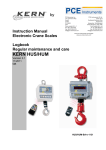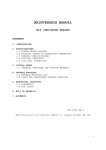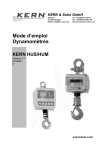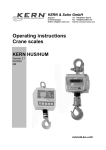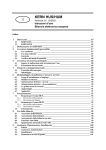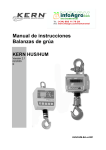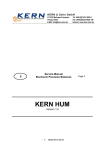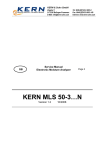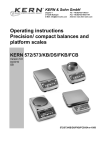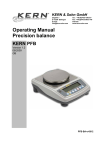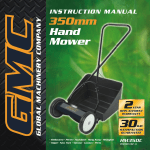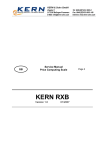Download KERN & Sohn GmbH
Transcript
KERN & Sohn GmbH D-72322 Balingen-Frommern Postfach 4052 E-Mail: [email protected] Tel: 0049-[0]7433-9933-0 Fax: 0049-[0]7433-9933-149 Internet: www.kern-sohn.de Service Manual Electronic Precision Balances page 2 KERN HUS version 1.0 HUS-SH-e-0110 KERN HUS version 1.0 Service Manual Electronic Precision Balances Table of Content 1. INTRODUCTION …………………………………………………………. 3 2. SPECIFICATION …………………………………………………………. 2.1 System Block Diagram ……………………………………………... 2.2 Physical Layout of Electrical Connection …………………………. 2.3 General Specification ……………………………………………….. 2.3.1 Overall View ……………………………………………….. 2.3.2 Dimensions ………………………………………………… 2.3.3 Model Specification ……………………………………….. 2.3.4 Operating Conditions ……………………………………… 2.3.5 Main Components ………………………………………… 2.3.6 Analog Specification ………………………………………. 2.3.7 Capacity & External Division …………………………….. 4 4 5 6 6 7 7 7 7 7 7 3. INITIAL SETUP ……………………………………………………………. 3.1 Internal Functions and Alternate Division …………………………. 3.2 Auto and Dealer Calibration ………………………………………… 3.3 Disable Calibration with Dip Switch (S1) ………………………….. 3.4 Offset and Span Value Data ……………………………………….. 3.5 Flow Chart ……………………………………………………………. 8 8 9 9 10 11 4. TROUBLE SHOOTING …………………………………………………… 16 4.1 Trouble Shooting Loop ………………………………………………. 16 4.2 Parts and Components Trouble Shooting …………………………. 17 4.2.1 Power Supply Check ………………………………………. 17 4.2.1.1 Relevant Parts ………………………………….. 17 4.2.1.2 Input Voltage: 5.5V or less …………………….. 18 4.2.1.3 Output Voltage of Regulation: 5V +/- 10% …… 18 4.2.2 Load Receptor Check ………………………………………. 18 4.2.3 LCD Display Check …………………………………………. 18 4.2.4 CPU Check …………………………………………………… 18 5. ELECTRICAL CIRCUITRY ………………………………………………… 19 5.1 Schematics ……………………………………………………………... 19 5.2 PCB Layout ……………………………………………………………... 21 6. PARTS LIST ………………………………………………………………….. 22 2 HUS-SH-e-0110 1. INTRODUCTION Features of the KERN HUS series: • • • • • • • • • • • • • • • • Full Tare Tare indicator Zero indicator Negative value indicator Special hold function 2 types of calibration dip switch to prevent end-user calibration optional backlighting built-in rechargeable battery operating time after fully charged 120 hrs. low-battery signal auto power saving function AC adaptor included LCD display – easy to read Optional IR remote controller Capacity: 60 kg, 150 kg, 300 kg, 600 kg HUS-SH-e-0110 3 2. SPECIFICATION 2.1 System Block Diagram Description: When a load is applied to the loadcell, the resistance to the excitation current in the strain gauge changes and the analog output signal varies. It is amplified and digitalized continuously by the A/D converter into a digital signal. Subsequently, the resulting count is processed and managed by the CPU. The CPU refers to the instructions from the keyboard and then conveys the output data to the LCD driver which formats the data into a readout for the display. 4 HUS-SH-e-0110 2.2 Physical Layout of Electrical Connection HUS-SH-e-0110 5 2.3 General Specification 2.3.1 Overall View 6 HUS-SH-e-0110 2.3.2 Dimensions 142mm width / 152mm length / 360mm height ---- 60 to 300 kg capacities 142mm width / 152mm length / 378mm height ---- 600kg capacity 2.3.3 Model Specification Display resolution: Internal resolution: Display: 1/3,000 (60kg, 150kg, 300kg, 600kg) 1/30,000 single-sided weight display with 5 digits 2.3.4 Operating Conditions Power source: Rechargeable battery (6V 10 Ah / 6V 4 Ah) or AC adaptor (DC 15V, 500mA / DC 9V, 500 mA) 0°C to 40°C 15% to 85% RH 1W/0.1W; 5W when charging Operating temperature: Operating humidity: Power Consumption: 2.3.5 Main Components Micro processor: Crystall oscillator: Display device: Loadcell: 89C51/80C31 6 MHz / 7.3728 MHz 7 segments LED display / Liquid Crystal Display (LCD) 350 resistance loadcell 2.3.6 Analog Specification Input sensitivity: Zero adjust range: Zero balance range: L/C applied voltage: Speed of A/D conversion: Internal resolution: 2mV/V 2% R.O. +/- 5% R.O. DC 5V 4 times / sec. 30,000 2.3.7 Capacity & External Division MODEL NO. HUS60K20 HUS150K50 HUS300K100 HUS600K200 HUS-SH-e-0110 CAPACITY 60 kg 150 kg 300 kg 600 kg EXTERNAL DIVISION 0.02 kg 0.05 kg 0.1 kg 0.2 kg 7 3. INITIAL SETUP 3.1 Internal Functions and Alternate Division Internal Function Table FUNCTION SYMBOL 1 F.1 2 F.2 3 F.3 4 F.4 DESCRIPTION Span value reading and dealer calibration Full display segment and max. capacity check Check offset value and scale configuration Auto power off setting How to enter the required function mode: a. Turn scale off b. Press and hold TARE, then turn scale on. Scale displays F.1 c. Press TARE until the required function number appears d. Press MODE e. Press MODE until the required setting appears f. Press TARE to confirm g. Repeat steps c. to f. for other function setting, or h. Press ZERO to save settings and return to normal operation 8 F.1 Span value reading and dealer calibration Simply enter F.1, then put on the designated mass to check span value or keep going to do dealer calibration F.2 Display segment and rated capacity & division check When function is entered, scale will first display the rated capacity and Division, then display all segment. Check and make sure that no segment is missed. F.3 Check offset value is within acceptable range and scale configuration 1. Enter F.3, scale displays the offset value 2. Hold MODE for about 2 sec. 3. Scale displays capacity and division configuration 4. Press MODE until the required configuration is obtained. Note: In some countries, only the metric weight unit is available. 5. Press ZERO to save setting and go back to normal operation status. F.4 Auto power off setting Two modes are available: (Default=4_OFF) 0._OFF = auto power off function is disabled 4._OFF = scale will automatically get turned off after 4 min. unused HUS-SH-e-0110 3.2 Auto and Dealer Calibration Acceptable load for auto and dealer calibration MODEL-NO. HUS60K20 HUS150K50 HUS300K100 HUS600K200 EXTERNAL DIVISION 1/3,000 1/3,000 1/3,000 1/3,000 ACCEPTABLE AUTO AND DEALER CALIBRATION LOAD 20 kg 40 kg 100 kg 200 kg 40 kg 100 kg 200 kg 400 kg Dealer calibration procedure: 1. Turn scale off 2. Press and hold TARE, then turn scale on 3. scale displays F.1 4. Press MODE 5. Scale displays offset value 6. Press ZERO to zero offset value 7. Press TARE 8. Press ZERO 9. Press TARE 10. Press ZERO, an arrow will appear at the right hand side of the display. It indicates that the scale is ready for dealer calibration. 11. Make sure that the displayed figure is “0” or “1”. If not, press ZERO again. 12. Load calibration of each load as listed in above table. 13. When displayed value is stable, press MODE. 14. Wait until the scale starts to count down. 15. Calibration is completed and scale is ready for operation. Auto calibration procedure: 1. Turn off scale. 2. Press and hold MODE, then turn on the scale. 3. Scale displays “CAL?” 4. Press MODE 5. Scale displays “LOAD XXXX” or “XXXX” 6. Load calibration, load according to above table 7. Wait until the scale displays “DONE” and starts to count down. 8. Calibration is completed and scale is ready for operation. 3.3 Disable Calibration with Dip Switch (S1) The Dip switch #1 is used to control calibration. Push the switch to “ON” position to disable calibration. HUS-SH-e-0110 9 3.4 Offset and Span Value Data MODEL-NO. EXTERNAL DIVISION OFFSET VALUE (thousand) HUS60K20 1/3,000 4~7 HUS150K50 1/3,000 4~7 HUS300K100 1/3,000 4~7 HUS600K200 1/3,000 4~7 SPAN VALUE (thousand) AT VARIOUS APPLIED LOADS 8~12 at 20kg, 20~30 at 50kg 8~12 at 50kg, 16~24 at 100kg 8~12 at 100kg, 20~30 at 200kg 8~12 at 200kg, 20~30 at 500kg OFFSET CONTROL VR1 Trimmer SPAN CONTROL (Ohm) R1A R1B 40K x VR1 Trimmer 40K x VR1 Trimmer 40K x VR1 Trimmer 40K x Reading offset value: 1. Turn scale off. 2. Remove all load from the platter. 3. Enter F.3 and read the offset value. Reading span value: 1. Turn scale off. 2. Remove all load from platter. 3. Enter F.1 4. Press ZERO 5. Apply load to platter. Span value according to applied load will be displayed. How to adjust offset value: In case the offset value is out of range, adjust the trimmer located at VR1 (TR2) on the mainboard to obtain correct offset value. How to adjust span value: The span value is controlled by resistor located on R1A and R1B. Standard resistor value of R1A and R1B is listed in the above table. If the required span value is not attained, then change R1A and/or R1B resistor according to either case below: Span value too low: Increase the resistance of R1A and/or R1B. Span value too high: Decrease the resistance of R1A and/or R1B. 10 HUS-SH-e-0110 3.5 Flow Chart Auto-calibration (for end-user) HUS-SH-e-0110 11 Function Test (for technicians only) 12 HUS-SH-e-0110 HUS-SH-e-0110 13 14 HUS-SH-e-0110 HUS-SH-e-0110 15 4. TROUBLE SHOOTING 4.1 Trouble Shooting Loop 16 HUS-SH-e-0110 4.2 Parts and Components Trouble Shooting 4.2.1 Power Supply Check 4.2.1.1 Relevant Parts HUS-SH-e-0110 17 Description: 1. AC adaptor: This AC adaptor provides about 9-12V DC power. 2. Battery: Built-in rechargeable battery 6V 4 Ah 3. How battery is charged completely? The charging voltage is regulated by Q1(C1061) and ZD1(8.2V) for about 7 volts. The charging current will go down automatically if the battery’s voltage is reached. Q2(C945) and R1(1.2R, 1/2W) provide over-current protection. 4. Charging status indications: LED turns RED (or ORANGE) → charging; LED turns GREEN → fully charged 5. Auto-off: If the scale is set on 4_OFF or even under LO-BAT situation after some minutes the CPU will release a negative pulse to cut off Q4 transistor, then Q1 will be cut off too. The scale is shut down immediately. 4.2.1.2 Input Voltage: 5.5V or less Check and recharge battery if voltage is less than 5.5V. Check and replace DC-JACK or AC adaptor if defective. 4.2.1.3 Output Voltage of Regulation: 5V +/- 10% Check that the output voltage is within 5V +/- 10%. At less than 2.7V the CPU may not work properly. At more than 6V ghost will appear on LCD. 4.2.2 Load Receptor Check The load receptor device shall not touch anything around itself during operation. Check that the load receptor is not contacted with the upper (no load) and/or lower (with load) stopper. 4.2.3 LCD Display Check Check that it is soldered and connected properly between LCD and driver IC(uPD7225), driver IC(uPD7225) and CPU. Check whether LCD is broken. 4.2.4 CPU Check Check that all pins are seated properly into the socket. Check that the crystal oscillator works. Check that RESET is normally low. When no error is found with the above checking procedures, the trouble can be caused by the loadcell or the PCB itself. Replace them by new components could be suitable to identify the cause of the trouble. In this way, the readout of weight would be varied because of the output voltage of the loadcell and the different span value. Therefore, re-calibration is required after this replacement. 18 HUS-SH-e-0110 5. ELECTRICAL CIRCUITRY 5.1 Schematics HUS-SH-e-0110 19 20 HUS-SH-e-0110 5.2 PCB Layout HUS-SH-e-0110 21 6. PARTS LIST 22 HUS-SH-e-0110 HUS-SH-e-0110 23 24 HUS-SH-e-0110
























